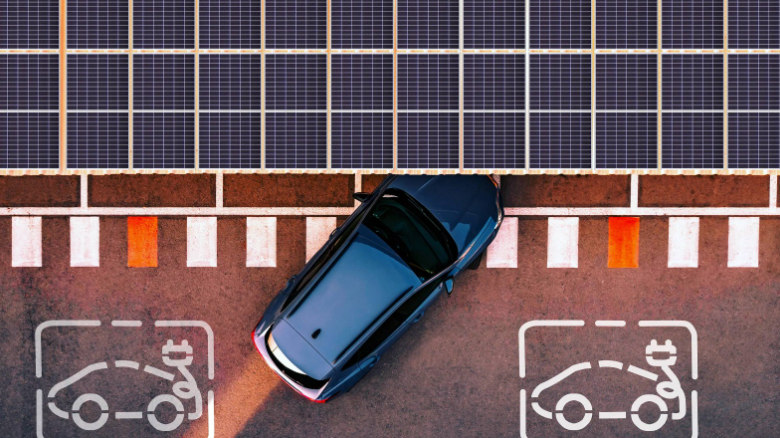Read by: 100 Industry Professionals

New Delhi: Sunlight is abundant in India, and with renewed government push for harnessing this free natural resource, the country is well on its way to significantly enhancing its rooftop solar power capacity. So how does the push for rooftop solar align with a parallel government initiative to promote the use of electric vehicles?
Increasing emphasis on rooftop solar energy generation makes EVs fully green from well to wheel as they can be conveniently charged from the energy produced without any use of fossil fuel while delivering the added benefit of near zero running costs. This further lowers the total cost of ownership of EVs. With the central and most state governments providing multiple subsidies and incentives for installing rooftop solar panels, the customer benefits exponentially. In addition, prices of EVs are reducing and fast becoming equivalent to similar petrol or diesel powered vehicles. This makes the combined value proposition of EV and Solar Charging most compelling.
Randheer Singh, CEO of ForeSee Advisors, an EV value chain consulting company, says that the government’s promotion of rooftop solar through various incentives is “indeed a significant factor contributing to the penetration of electric vehicles (EVs) in India, although it operates as part of a broader ecosystem. Rooftop solar solutions provide a sustainable and cost-effective way for consumers to generate their own electricity. This becomes particularly relevant for EV owners, as the ability to charge their vehicles using solar power not only reduces dependence on the grid but also significantly lowers the total cost of ownership over time. This synergy between renewable energy and EVs aligns with the government’s broader agenda of reducing carbon emissions and promoting energy security.”
Government push for solar
The government has been doing its bit to promote rooftop solar installation. Under the Pradhan Mantri Surya Ghar Muft Bijli Yojana, each household that opts for the installation of a rooftop solar system is entitled to 300 units of electricity free every month. The scheme is targeting solar panel installation across one crore households and has been allocated Rs 75,021 crore.
The scheme provides a subsidy of 60% of the solar unit cost for systems up to 2 kW capacity and 40% of the additional system cost for systems between 2 kW to 3 kW capacity. The subsidy has been capped at 3 kW capacity. An official statement earlier this year had said that “At current benchmark prices, this will mean Rs 30,000 subsidy for 1 kW system, Rs 60,000 for 2 kW systems, and Rs 78,000 for 3 kW systems or higher.”
Another feature of this scheme is that interested households are allowed to access collateral-free, low-interest loan products of around 7% for the installation of residential RTS systems up to 3 kW. The interest rate has been pegged at 0.5% above the prevailing Repo Rate decided by the Reserve Bank of India from time to time.
The PM Surya Ghar Muft Bijlee Yojana promises an assured saving of approximately Rs 15,000 in a year for a household consuming up to 300 units a month by installing a rooftop solar unit of 3 kW capacity. Such a household, by generating its own electricity, will save approximately Rs 1,800–Rs 1,875 on electricity bills.
The official statement quoted earlier said that even after deducting the EMI of Rs 610 on the loan availed for financing the solar unit, the saving would be around Rs 1,265 per month or approximately Rs 15,000 in a year. The savings for households not availing loans will be even higher.
In addition, many progressive states including Gujarat, Maharashtra, Kerala, Karnataka and Rajasthan are already offering additional subsidies to households for installing solar panels and several more are working on policies to incentivise this.
India’s journey towards net zero emissions
EVs with zero tailpipe emissions and solar power systems, which generate emissions-free electricity are both key enablers in India’s journey towards net zero emissions. Tata Passenger Electric Mobility (TPEML) and Tata Power Renewable Energy (TPREL), a subsidiary of The Tata Power Company Ltd., have announced a collaboration to drive zero-emissions mobility through a combined solution of electric vehicles and solar rooftop systems.
TPEML MD Shailesh Chandra says, “We see significant synergies between the customers of EVs and solar rooftop systems. Over 90% of EV customers use home charging and nearly 30% of our EV owners are already using solar rooftop systems. Combining forces with TPREL, we intend to democratise zero-emissions mobility and decouple EVs from the grid while reducing running costs for customers.”
Bhawna Tyagi, Programme Lead at the Council on Energy, Environment, and Water (CEEW), says that India has a rooftop solar potential of 637 GW. “Tapping this can help meet the residential electricity demand, which is rising due to factors like increasing EV penetration, growing urbanisation, increasing per capita income leading to increasing appliance penetration, etc., while alleviating the financial strain on discoms and reducing dependency on fossil fuels. For a Vikasit Bharat, empowering households with rooftop solar is essential.”
Zero emission EV sales though rising year on year, currently account for just 2-3% of total industry volumes. They have an important role to play in reducing the carbon output of India’s automotive industry. With the government having set an ambitious target of 30% EV penetration by the turn of this decade, we must as a nation integrate EV adoption with the broader UN Sustainable Development Goals for the growth of EVs is core to address issues of serious air pollution, energy security, sustainable mobility, and economic stability.

